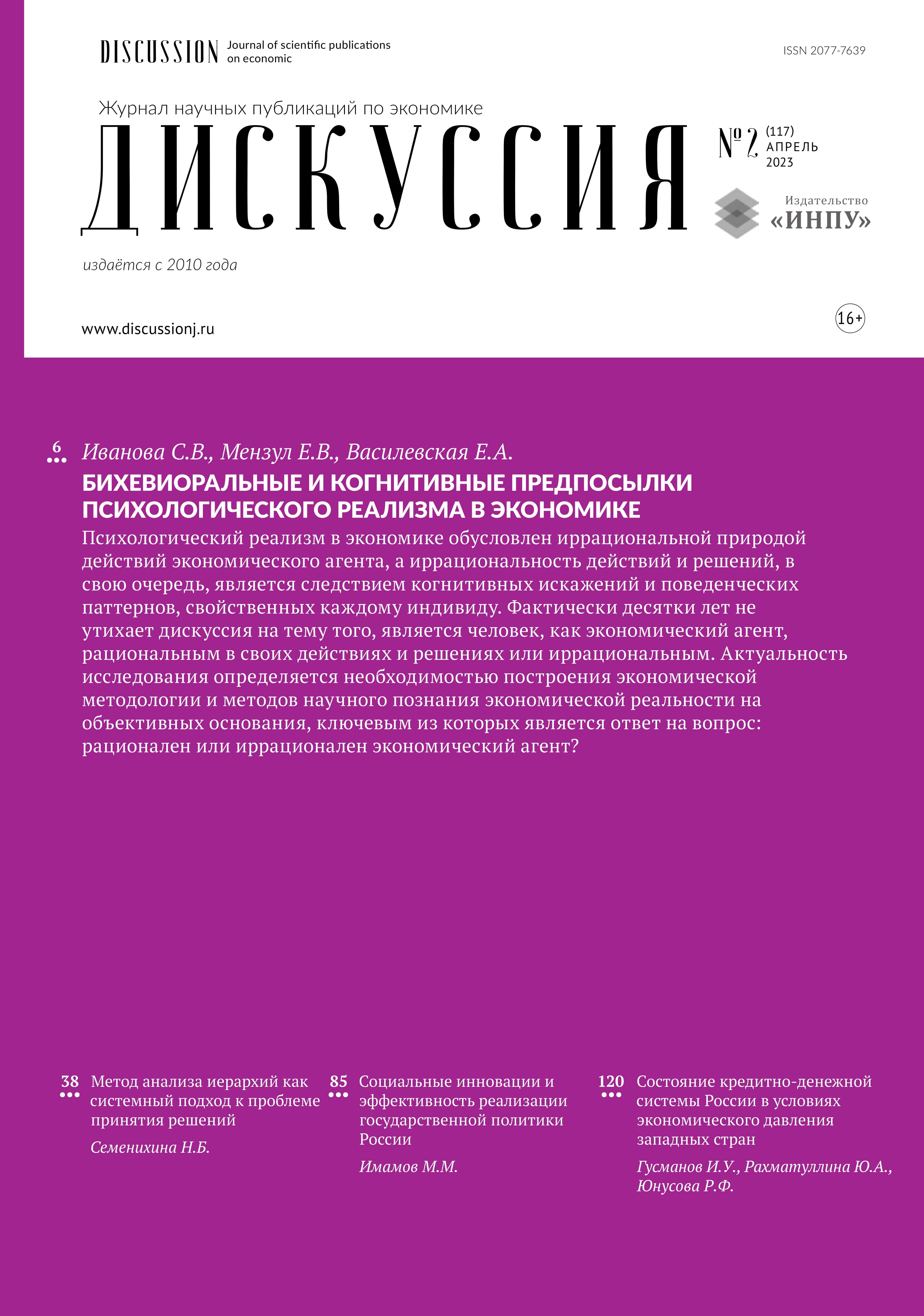HIERARCHY ANALYSIS METHOD AS A SYSTEMATIC APPROACH TO THE PROBLEM OF DECISION-MAKING
Keywords:
Vector algebra, combinatorics, technical solution, economic solution, consistency of results, graph theory, comparison matrix, priority matrixAbstract
The need to make decisions is an integral part of conscious human life, a person makes decisions every day, from small decisions that determine the content of his daily life to more important decisions that affect the state of social groups, social systems, economic entities. The relevance of the research is determined by the need to make decisions based on quantitatively based, objective methods that minimize uncertainty and subjectivity of the decision-making process. The object of the study is decision-making as a conscious human action. The subject of the study is a quantitatively based decision-making method, which is a mathematical procedure. The purpose of the study is to consider the method of hierarchy analysis as an analytical hierarchical process that is an effective decision–making tool. In the course of the research, it was revealed that the hierarchy analysis method is an alternative to formal logical methods, tools of vector algebra, combinatorics, graph theory. The intensity scale from 1 to 9 is presented, which is an important tool in the method of hierarchy analysis and which helps to make complex decisions, taking into account a variety of criteria and alternatives. An example of Python code for implementing the hierarchy analysis method by software is presented, which consists of four steps and can be used to solve various tasks, such as supplier selection, project management, product development and environmental impact assessment.
Downloads
Metrics
References
Орлов, А. И. Теория принятия решений : учебник / А. И. Орлов. – Москва : Издательство "Экзамен", 2006. – 573 с. – ISBN 5-472-01393-3. – EDN QRGWFN.
Сорина, Г. В. Основы принятия решений / Г. В. Сорина. – Москва : Издательство "Экономист", 2004. – 188 с. – ISBN 5-98118-058-7. – EDN WBQSVL.
Антонова, А. С. Многокритериальное принятие решений в условиях риска на основе интеграции мультиагентного, имитационного, эволюционного моделирования и численных методов / А. С. Антонова, К. А. Аксенов // Инженерный вестник Дона. – 2012. – № 4-2(23). – С. 99. – EDN PVJDHJ.
Дегтярева, Н. А. Принятие эффективных управленческих решений на основе эконометрического прогнозирования / Н. А. Дегтярева, Н. А. Берг // Вестник Челябинского государственного университета. – 2018. – № 7(417). – С. 176-183. – DOI 10.24411/1994-2796-2018-10721. – EDN XZLBBZ.
Гришина, Т. Г. Вероятностное обоснование и принятие решений при управлении автоматизированным производством / Т. Г. Гришина // Мехатроника, автоматизация, управление. – 2012. – № 1. – С. 48-52. – EDN OOGPCD.
Edwards W. Behavioral decision theory //Annual review of psychology. – 1961. – Т. 12. – №. 1. – С. 473-498.
Pratt J. W. et al. Introduction to statistical decision theory. – MIT press, 1995.
Kaplan J. Decision theory and the factfinding process //Stan L. Rev. – 1967. – Т. 20. – С. 1065.
Berger J. Statistical decision theory: foundations, concepts, and methods. – Springer Science & Business Media, 2013.
Blume L., Easley D., Halpern J. Y. Constructive decision theory //Journal of Economic Theory. – 2021. – Т. 196. – С. 105306.
Блягоз, З. У. Принятие решений в условиях риска и неопределенности / З. У. Блягоз, А. Ю. Попова // Вестник Адыгейского государственного университета. – 2006. – № 4. – С. 164-168. – EDN KAOVEZ.
Принятие технических решений в условиях неопределенности при наличии риска / В. В. Дерюшев, Е. Е. Косенко, В. В. Косенко, М. М. Зайцева // Безопасность техногенных и природных систем. – 2019. – № 2. – С. 56-61. – DOI 10.23947/2541-9129-2019-2-56-61. – EDN SUGQZR.
Małecka M. The normative decision theory in economics: A philosophy of science perspective. The case of the expected utility theory //Journal of Economic Methodology. – 2020. – Т. 27. – №. 1. – С. 36-50.- DOI 10.1080/1350178X.2019.1640891.
Sozzo S. Explaining versus describing human decisions: Hilbert space structures in decision theory //Soft Computing. – 2020. – Т. 24. – №. 14. – С. 10219-10229. - DOI 10.1007/s00500-019-04140-x.
Принятие решений по статистическим моделям в управлении качеством продукции / Г. М. Журавлев, А. Е. Гвоздев, С. В. Сапожников [и др.] // Известия Юго-Западного государственного университета. – 2017. – № 5(74). – С. 78-92. – DOI 10.21869/2223-1560-2017-21-5-78-92. – EDN YMOZXF.
Левин, В. И. Логико-математические методы и их применения / В. И. Левин // Системы управления, связи и безопасности. – 2018. – № 2. – С. 213-244. – EDN XQDBYL.
Аликаев, Р. С. "Схемы действования" как маркер дискурсивности научного текста: формальная логика vs. герменевтика / Р. С. Аликаев, С. Н. Бредихин // Вестник Волгоградского государственного университета. Серия 2: Языкознание. – 2015. – № 2(26). – С. 121-127. – DOI 10.15688/jvolsu2.2015.2.17. – EDN UGJCWP.
Чагров, А. В. Формальная пропозициональная логика А.Виссера и ее расширения / А. В. Чагров // Логические исследования: ежегодник. – 2003. – № 10. – С. 204-211. – EDN SEDSGF.
Дорфман, Я. Формальная логика как знаковая система / Я. Дорфман, В. М. Сергеев // Метод. – 2014. – № 4. – С. 44-61. – EDN TBHMIR.
Карпович, В. Н. Формальная логика, риторика и рациональная аргументация / В. Н. Карпович // Сибирский философский журнал. – 2019. – Т. 17, № 1. – С. 5-16. – DOI 10.25205/2541-7517-2019-17-1-5-16. – EDN WWLIQM.
Горюнов, Е. В. Матрично-векторный метод оценки эффективности инвестиционных решений / Е. В. Горюнов // Экономический анализ: теория и практика. – 2015. – № 30(429). – С. 34-42. – EDN UDZDWV.
Птускин, А. С. Многокритериальная модель определения наилучшей доступной технологии при нечетких исходных данных / А. С. Птускин, Е. Левнер, Ю. М. Жукова // Вестник Московского государственного технического университета им. Н.Э. Баумана. Серия Машиностроение. – 2016. – № 6(111). – С. 105-127. – EDN UYYOXB.
Карелин, В. П. Модели и методы теории графов в системах поддержки принятия решений / В. П. Карелин // Вестник Таганрогского института управления и экономики. – 2014. – № 2(20). – С. 69-73. – EDN UCGQRX.
Saaty T. L. A scaling method for priorities in hierarchical structures //Journal of mathematical psychology. – 1977. – Т. 15. – №. 3. – С. 234-281.
Saaty T. L. Axiomatic foundation of the analytic hierarchy process //Management science. – 1986. – Т. 32. – №. 7. – С. 841-855. -DOI 10.1287/mnsc.32.7.841.
Saaty T. L. How to make a decision: the analytic hierarchy process //Interfaces. – 1994. – Т. 24. – №. 6. – С. 19-43.
Saaty T. L., Vargas L. G. Decision Making in Economic, Social and Technological Environments. – 2006.
Downloads
Published
How to Cite
Issue
Section
Categories
License
Copyright (c) 2023 Н.Б. Семенихина

This work is licensed under a Creative Commons Attribution-NonCommercial-NoDerivatives 4.0 International License.
Авторы, публикующие произведения в журнале «Дискуссия», соглашаются со следующими условиями:
- Авторы сохраняют за собой авторское право и предоставляют журналу право первой публикации произведения, одновременно лицензированной в соответствии с лицензией Creative Commons Attribution, позволяющей другим лицам пользоваться произведением с подтверждением авторства и первоначальной публикации в журнале «Дискуссия».
- Авторы вправе заключать с иными лицами лицензионные договоры на условиях простой (неисключительной) лицензии на использование опубликованного в журнале «Дискуссия» произведения (например, размещение его в базах данных университетов, публикация в книге), со ссылкой на его оригинальную публикацию в этом журнале.
- Автор гарантирует, что является правообладателем всех материалов, предоставляемых в редакцию, и что исключительные права на данные материалы не переданы или не предоставлены другим лицам.
- Авторам разрешено и рекомендуется размещать свое произведение в Интернете до и во время процесса подачи, поскольку это может привести к продуктивному обмену, а также к более раннему и более широкому цитированию опубликованных работ.
С момента загрузки произведения и сопроводительных материалов через раздел "Отправка материалов", автор полностью и безоговорочно принимает (акцептует) публичную оферту о заключении авторского соглашения об опубликовании произведения. В соотвтетствии с этим соглашением автор предоставляет издателю на безвозмездной основе неисключительную лицензию на использование созданного автором произведения.
С момента получения произведения и прилагаемых к нему материалов журнал "Дискуссия" вправе использовать полученные произведения без ограничений по своему усмотрению и в пределах всего срока действия исключительных прав, но с обязательным указанием имени автора (авторов) произведения, в том числе публиковать произведения (полностью или в сокращении) на территории всего мира, переводить на другие языки, направлять в репозитории научной информации, размещать в сети Интернет и использовать другими законными способами.









